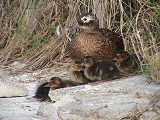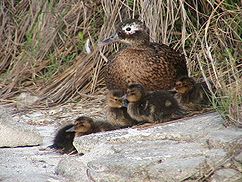
Minimum Viable Population
Encyclopedia
Minimum viable population (MVP) is a lower bound on the population of a species, such that it can survive in the wild. This term is used in the fields of biology, ecology
, and conservation biology
. More specifically MVP is the smallest possible size at which a biological population can exist without facing extinction from natural disasters or demographic, environmental, or genetic stochastic
ity. The term "population" refers to the population of a species in the wild. For example, the undomesticated dromedary
camel is extinct in its natural wild habitat; but there is a domestic population in captivity and an additional feral population
in Australia
. Two groups of house cats in separate houses which are not allowed outdoors are also technically distinct populations. Typically, however, MVP is used to refer solely to a wild population, such as the red wolf
.
s for population viability analyses
(PVA). PVA models populations using demographic and environmental information to project future population dynamics. The probability assigned to a PVA is arrived at after repeating the environmental simulation thousands of times.
For example, a simulation of a population of fifty giant pandas in which the simulated population goes completely extinct thirty out of one hundred stochastic simulations when projected one hundred years into the future is not viable. Causes of extinction in the simulation may include inbreeding depression
, natural disaster
, or climate change
. Extinction occurring thirty out of one hundred runs would give a survival probability of seventy percent. In the same simulation with a starting population of sixty pandas, the panda population may only go extinct on four of the hundred runs for a survival probability of 96 percent. In this case the minimum viable population that satisfies the 90 to 95 percent probability for survival is between 50 and 60 pandas. (Numbers and species were invented for the purpose of this example).
 MVP does not take human intervention into account. Thus, it is useful for conservation managers and environmentalists; a population may be increased above the MVP using a captive breeding program, or by bringing other members of the species in from other reserves.
MVP does not take human intervention into account. Thus, it is useful for conservation managers and environmentalists; a population may be increased above the MVP using a captive breeding program, or by bringing other members of the species in from other reserves.
There is naturally some debate on the accuracy of PVAs, since a wide variety of assumptions generally are required for future forecasting; however, the important consideration is not absolute accuracy, but promulgation of the concept that each species indeed has an MVP, which at least can be approximated for the sake of conservation biology and Biodiversity Action Plan
s.
There is a marked trend for insularity
, surviving genetic bottlenecks and r-strategy to allow far lower MVPs than average. Conversely, taxa easily affected by inbreeding depression – having high MVPs – are often decidedly K-strategists, with low population densities while occurring over a wide range. An MVP of 500 to 1,000 has often been given as an average for terrestrial vertebrates when inbreeding or genetic variability is ignored. When inbreeding effects are included, estimates of MVP for many species are in the 1,000s. Based on a meta-analysis of reported values in the literature for many species, Traill et al. reported a median MVP of 4,169 individuals.
Ecology
Ecology is the scientific study of the relations that living organisms have with respect to each other and their natural environment. Variables of interest to ecologists include the composition, distribution, amount , number, and changing states of organisms within and among ecosystems...
, and conservation biology
Conservation biology
Conservation biology is the scientific study of the nature and status of Earth's biodiversity with the aim of protecting species, their habitats, and ecosystems from excessive rates of extinction...
. More specifically MVP is the smallest possible size at which a biological population can exist without facing extinction from natural disasters or demographic, environmental, or genetic stochastic
Stochastic
Stochastic refers to systems whose behaviour is intrinsically non-deterministic. A stochastic process is one whose behavior is non-deterministic, in that a system's subsequent state is determined both by the process's predictable actions and by a random element. However, according to M. Kac and E...
ity. The term "population" refers to the population of a species in the wild. For example, the undomesticated dromedary
Dromedary
The dromedary or Arabian camel is a large, even-toed ungulate with one hump on its back. Its native range is unclear, but it was probably the Arabian Peninsula. The domesticated form occurs widely in North Africa and the Middle East...
camel is extinct in its natural wild habitat; but there is a domestic population in captivity and an additional feral population
Australian feral camel
Thousands of the two main species of Australian feral camels, mostly dromedaries but also some bactrian camels, were imported into Australia during the 19th century for transport and construction as part of the colonisation of the central and western parts of Australia. Motorised transport replaced...
in Australia
Australia
Australia , officially the Commonwealth of Australia, is a country in the Southern Hemisphere comprising the mainland of the Australian continent, the island of Tasmania, and numerous smaller islands in the Indian and Pacific Oceans. It is the world's sixth-largest country by total area...
. Two groups of house cats in separate houses which are not allowed outdoors are also technically distinct populations. Typically, however, MVP is used to refer solely to a wild population, such as the red wolf
Red Wolf
The red wolf is a North American canid which once roamed throughout the Southeastern United States and is a glacial period survivor of the Late Pleistocene epoch...
.
Estimating the MVP
Minimum Viable Population is usually estimated as the population size necessary to ensure between 90 and 95 percent probability of survival between 100 to 1,000 years into the future. The MVP can be estimated using computer simulationComputer simulation
A computer simulation, a computer model, or a computational model is a computer program, or network of computers, that attempts to simulate an abstract model of a particular system...
s for population viability analyses
Population viability analysis
Population viability analysis is a species-specific method of risk assessment frequently used in conservation biology.It is traditionally defined as the process that determines the probability that a population will go extinct within a given number of years.More recently, PVA has been described...
(PVA). PVA models populations using demographic and environmental information to project future population dynamics. The probability assigned to a PVA is arrived at after repeating the environmental simulation thousands of times.
For example, a simulation of a population of fifty giant pandas in which the simulated population goes completely extinct thirty out of one hundred stochastic simulations when projected one hundred years into the future is not viable. Causes of extinction in the simulation may include inbreeding depression
Inbreeding depression
Inbreeding depression is the reduced fitness in a given population as a result of breeding of related individuals. It is often the result of a population bottleneck...
, natural disaster
Natural disaster
A natural disaster is the effect of a natural hazard . It leads to financial, environmental or human losses...
, or climate change
Climate change
Climate change is a significant and lasting change in the statistical distribution of weather patterns over periods ranging from decades to millions of years. It may be a change in average weather conditions or the distribution of events around that average...
. Extinction occurring thirty out of one hundred runs would give a survival probability of seventy percent. In the same simulation with a starting population of sixty pandas, the panda population may only go extinct on four of the hundred runs for a survival probability of 96 percent. In this case the minimum viable population that satisfies the 90 to 95 percent probability for survival is between 50 and 60 pandas. (Numbers and species were invented for the purpose of this example).
MVP and extinction

There is naturally some debate on the accuracy of PVAs, since a wide variety of assumptions generally are required for future forecasting; however, the important consideration is not absolute accuracy, but promulgation of the concept that each species indeed has an MVP, which at least can be approximated for the sake of conservation biology and Biodiversity Action Plan
Biodiversity Action Plan
A Biodiversity Action Plan is an internationally recognized program addressing threatened species and habitats and is designed to protect and restore biological systems. The original impetus for these plans derives from the 1992 Convention on Biological Diversity...
s.
There is a marked trend for insularity
Island
An island or isle is any piece of sub-continental land that is surrounded by water. Very small islands such as emergent land features on atolls can be called islets, cays or keys. An island in a river or lake may be called an eyot , or holm...
, surviving genetic bottlenecks and r-strategy to allow far lower MVPs than average. Conversely, taxa easily affected by inbreeding depression – having high MVPs – are often decidedly K-strategists, with low population densities while occurring over a wide range. An MVP of 500 to 1,000 has often been given as an average for terrestrial vertebrates when inbreeding or genetic variability is ignored. When inbreeding effects are included, estimates of MVP for many species are in the 1,000s. Based on a meta-analysis of reported values in the literature for many species, Traill et al. reported a median MVP of 4,169 individuals.
Population uncertainty
Population uncertainty may be divided into four sources:- Demographic stochasticity
- Environmental stochasticity
- Natural catastrophes
- Genetic stochasticity

